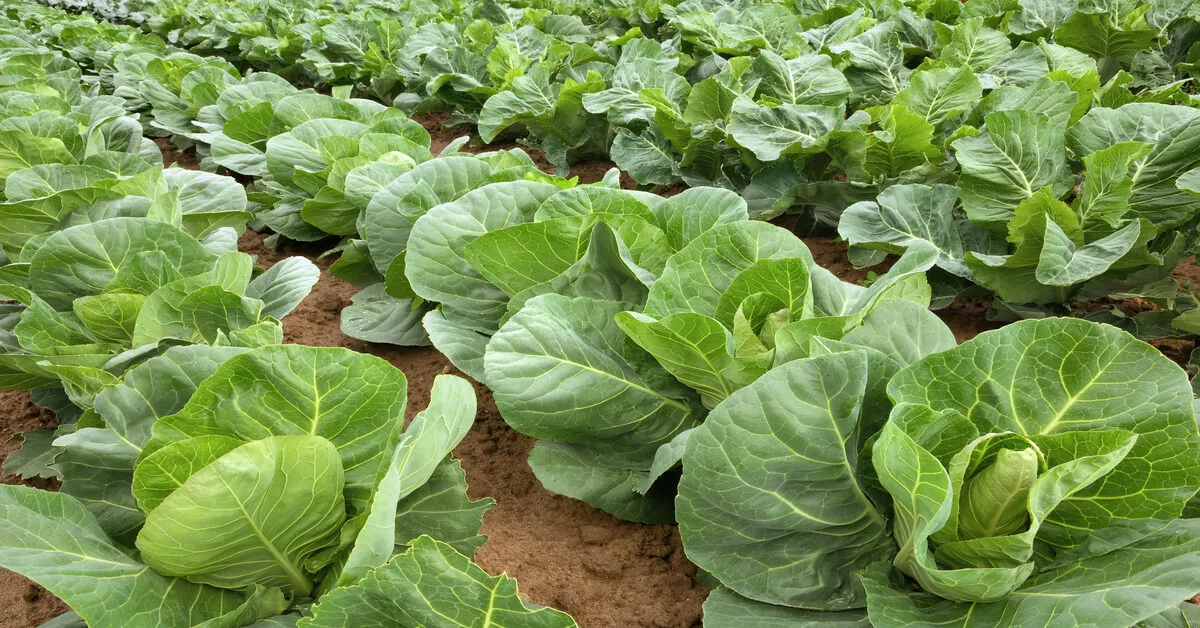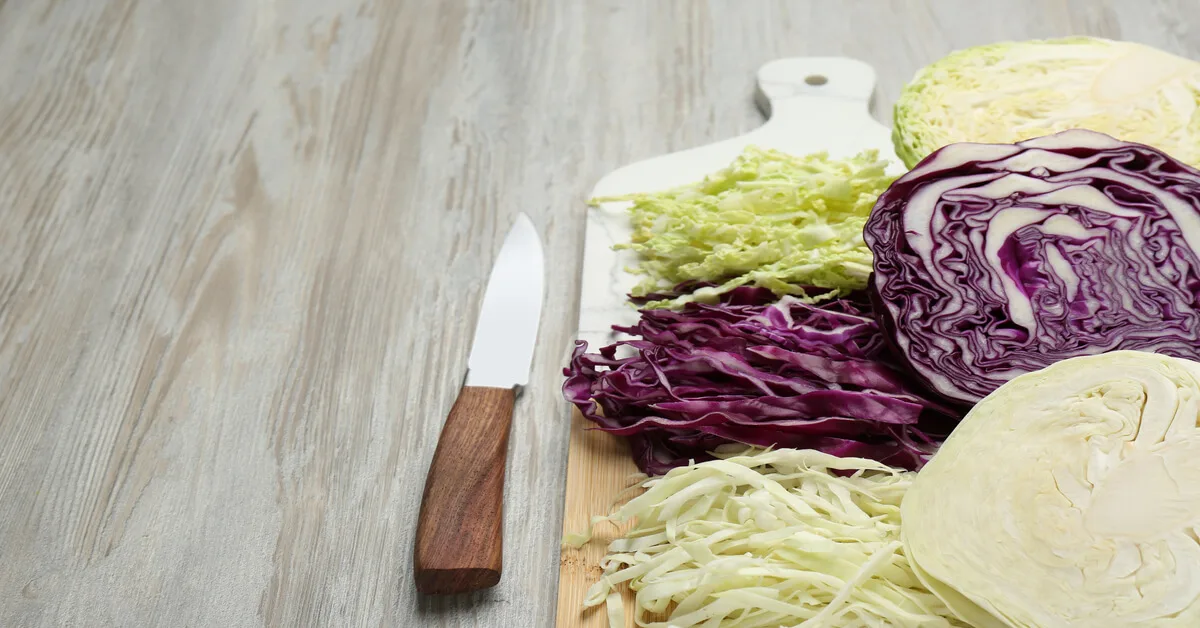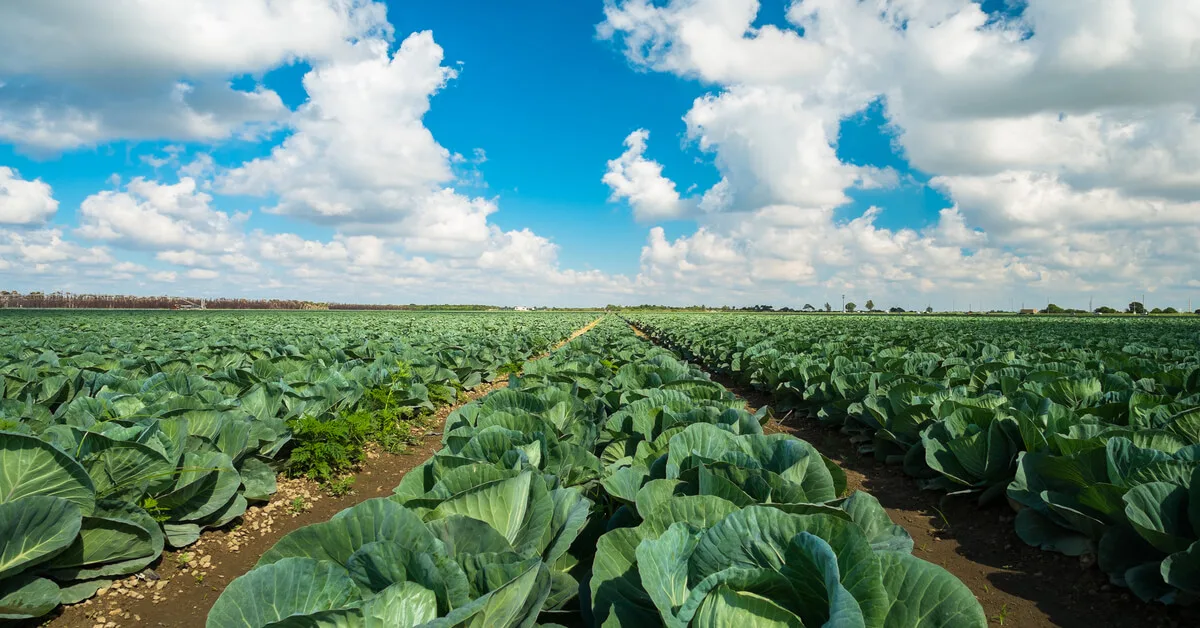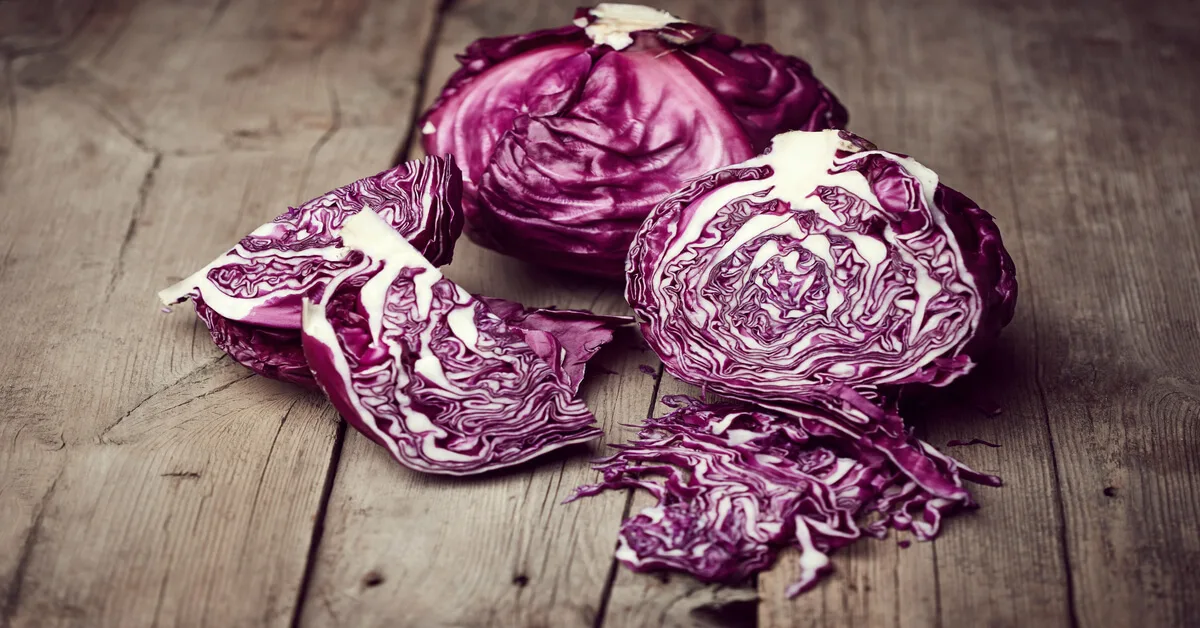If you’re thinking about what to plant in the spring, you may want to consider growing cabbage. The Celts of Western Europe made cabbage popular, and we can see why [1]. That’s because it’s easy to grow, delicious, and can be propagated repeatedly.
If you want to grow this sustainable and tasty cruciferous vegetable, keep reading. We’re here to share care instructions, growing tips, and cabbage gardening techniques!
| Scientific name | Brassica oleracea |
| Common names | Cabbage, Green Cabbage, Red Cabbage, Purple Cabbage, and Savoy Cabbage. |
| Family | Brassicaceae (mustard family) |
| Genus | Brassica |
| Species | Oleracea |
| Origin | Mediterranean region of Europe |
| Growth habit | A perennial with broad green leaves that grow in an upright habit and form a dense ball in the center. |
| Leaves | Light to dark green broad leaves that wrap around the center of the plant, forming the cabbage. |
| Flower | Small yellow buttercup-like blooms that appear when bolting. |
| Height | 12″ to 14″ |
| Soil type/pH | High organic matter sandy loamy. Prefers pH of 5.8 to 6.5. |
| Germination time | 3 to 4 days |
| Hardiness | 6-9 (USDA) |
Cabbage Plant Care

Cabbages are an easy vegetable to grow and maintain. All you need to know is the basics of their care.
If you have just planted cabbage seeds and need to know how to care for budding plants, we have you covered!
Soil
The best soil type for growing cabbages is sandy loams with high organic matter content. Additionally, you should aim for a pH of 5.8 to 6.5. If you are unsure of the current pH of your soil, perform a soil test. The test will show the current pH level of your soil and give you insight into which fertilizers you should add.
Watering
The watering requirements for cabbage plants are simple. The primary goal of a watering routine for the plant is to keep the soil consistently moist. If your soil dries quickly, you may need to water the plants to a depth of 6″ several times a week. But if your soil maintains moisture, you can water to the same depth less frequently.
Lighting
For optimal results it is best to grow cabbages in full sun for six to eight hours per day. Although, the plant can tolerate partial shade if you don’t have the ideal garden space.
Humidity & Temperature
Like lettuce, cabbages grow best in temperatures of 60°F to 65°F or 15.56°C to 18.3°C. As you can see, they like the cooler seasons. Although, if it’s too cold outside, the plant is subject to bolting. Prolonged temperatures of 30°F to 50°F or -1.1°C to -10°C are the culprit of the undesirable effect. Although, you want to plant early enough in spring to avoid overly high temperatures.
Also, cabbages prefer the humidity conditions of zones six through nine. Growing in these zones during the ideal season will provide the perfect conditions.
Fertilizing
As stated previously, a soil test can give insight into which fertilizers you should use. Also, we must remember that the goal is to have a soil pH of 5.8 to 6.5. But there is still a fertilizing option if you are unable to test your soil.
One of the best fertilizers for growing cabbages is a NPK at a 5-10-10 ratio. The fertilizer mixture should be applied at 3lbs per 100sqft when the soil quality is unknown. Additionally, you should side-dress cabbages once in the growing season. You can side dress with a 34-0-0 (nitrogen) ratio or 15.5-0-0 (calcium nitrate) at 0.02. Also, it’s important to add you do not need as much fertilizer. A 1lbs bag is enough to cover 100′ of row.
Propagation
Get the most out of growing your cabbages by propagating them for future plants! By simply saving the bottom of the cabbage, you can propagate the leafy vegetable. All you need to do is place the cut bottom over a glass of water with the bottom touching the water. A mason jar works well for that task. After, place the glass where it can receive indirect sunlight for eleven to fourteen days. Once roots appear after eleven to fourteen days, you can transplant the cutting and grow as usual.
Diseases & Pests
Two things you should watch out for when growing cabbage plants are diseases and pests.
The most notable cabbage plant diseases are clubroot, black rot, and Alternaria. Thankfully, there are cultural practices that help mitigate and prevent diseases. Some of those practices include moisture control, removal, crop rotation, and more [2].
As for pests, you will need to keep an eye out for cabbage maggots, cabbage loopers, and cabbage worms. Additionally, diamondback moths and flea beetles are of concern. Insecticides, both natural and conventional, can be useful in the mitigation. Although, the earlier you notice these pests and apply insecticide, the better results you will have.
Days to Maturity
The average cabbage takes 60 to 100 days to mature. Although, some varieties may take longer. This is a slightly slower growth rate compared to other similar veggies, such as lettuce and cauliflower.
Harvesting

Cabbage plants are ready for harvest once they reach maturity and before. As previously stated, this typically takes between 60 to 100 days.
To harvest a cabbage, cut at the base with a sharp gardening knife. If you plan to propagate your cabbage heads, ensure to remove the full head with the plant. Once you have harvested the plant, remove the root system and stems to prevent diseases in the soil. Do not clean them before storing them in your fridge to avoid spoiling. It is best to clean the vegetable once you are ready to consume it.
How to Plant & Grow Cabbage

It’s great to learn about a plant’s care and needs, but what if it’s your first time planting it? You will need to know when to plant it, where to plant it, and how to plant it. If you find yourself in this situation, we have you covered. So here is when, where, and how to plant cabbage seeds.
- When to Plant
It is best to plant cabbage seeds in the spring and mid to late summer. For a summer harvest, start seeds indoors at the beginning of April. You can then transplant them to your garden beds in four to six weeks. But if you would like a fall harvest, you can directly sow the seeds in early July.
- Where to Plant
Cabbage plants thrive when growing in USDA zones six through nine. They should be planted in a location that receives full sun exposure for six to eight hours in sandy loamy soil. The soil should also have high organic matter content and a pH of 5.8 to 6.5.
- How to Plant
Now it’s officially time to plant. To start, cabbage plant spacing needs to be 15″ to 18″ apart. After you have the spacing down, plant the seeds 1/4″ deep into the soil. Cover the seeds in the soil and water in place. Once the seedlings sprout in six to ten days after germination, thin so there is only one seedling/leaf. So, now you are officially on your way to growing cabbages!
Cabbage Growing Stages
Having insight into how a plant grows can help you when tending to it and caring for it. You will have a better understanding of what to look for if problems arise. So, to help you successfully grow cabbage seeds, let’s discuss the growing stages.
Germination
As with any plant growing from seed, first comes the germination stage. In this stage, cabbage seeds will take three to four days to germinate. Weather, moisture, and soil conditions should be optimal in this stage for success. You can refer to the cabbage plant care section to learn what conditions are optimal.
Seedling
Six to ten days following germination, the cabbage will enter the seedling stage. In this stage, the plant begins to form and sprout. It will have a small formation of leaves, as well as roots and stems.
Vegetative
Next, we enter the vegetative stage. In this stage, the seedling’s embryonic structures will elongate and expand. That is so they can perform critical physiological tasks. Some of those critical tasks include absorbing nutrients and water, transpiration, and photosynthesis.
Flowering
Lastly, we enter the flowering stage, also known as bolting. In this stage, cabbages will have reached maturity and begin to grow flowers. That is so the plant can reproduce by dropping seeds. You will want to harvest them before they flower, as it changes the flavor and texture of the plant. The average cabbage plant is ready to harvest between 60 and 100 days.
Cabbage varieties

There are three main categories that common cabbage varieties fall into. Those categories include green cabbage, red/purple cabbage, and savoy cabbage. Green cabbages are more commonly grown than the other varieties. They have an earthy and peppery flavor. Red and purple cabbages are popular for use in salads and are growing in popularity. Savoy cabbages are also green and have sweeter flavoring than traditional green cabbage.
- Green Cabbage
Early Jersey Wakefield: This green variety has a pointed head and matures in 63 days.
King Cole: A firmer variety that has a uniform head and matures in 74 days.
Cheers: This green cabbage variety has solid rounded heads and matures in 75 days.
Cannonball Cabbage: A tight round head variety that matures in 8 to twenty weeks.
- Red Cabbage and Purple Cabbage
Ruby Ball: A variety that is notable for its cold and heat resistance, bursts slowly, and matures in 71 days.
Red Meteor: A firm red/purple cabbage that matures in 75 days.
Buscaro: A round to oblong red cabbage that takes 98 days to reach maturity.
- Savoy Cabbage
Savoy King: A tight uniform savoy cabbage that matures in 85 days.
Savoy Queen: A notable heat-tolerant variety that matures in 88 days.
Famosa: A variety that is slightly resistant to downy mildew and reaches maturity in 81 days.
Cabbage vs Iceberg Lettuce
The main differences between cabbage and iceberg lettuce are their textures and flavors. Cabbages have an earthy and peppery flavor and are crunchier in texture. In contrast, iceberg lettuce has a clean crisp taste with a less crunchy texture. Additionally, the plants come from two different families. Cabbages come from the Brassicaceae (mustard) family. Iceberg lettuce comes from the Asteraceae (daisy) family.
References:
[1] Of Cabbages and Celts. Aggie Horticulture. (n.d.). Retrieved January 31, 2023, from https://aggie-horticulture.tamu.edu/archives/parsons/publications/vegetabletravelers/cabbage.html
[2]Grabowski, M. (n.d.). Growing healthy vegetables. University of Minnesota Extension. Retrieved January 31, 2023, from https://extension.umn.edu/planting-and-growing-guides/growing-healthy-vegetables#remove-diseased-plant-material-1142513

